Friday, January 5, 2024. Annette’s News Roundup.
I think the Roundup makes people feel not so alone.
To read an article excerpted in this Roundup, click on its blue title. Each “blue” article is hyperlinked so you can read the whole article.
Please feel free to share.
Invite at least one other person to subscribe today! https://buttondown.email/AnnettesNewsRoundup
____________________________
Joe is always busy.
Today, the President will start his campaign at Valley Forge, making clear that our Democracy is on the line in the 2024 Election.
Here is the first ad for Biden-Harris 2024. Touch to watch.👇
BREAKING: President Biden just dropped his first ad of 2024. President Biden makes abundantly clear freedom is on the line. Retweet to make sure everyone sees. pic.twitter.com/3lDEr7Z07N
— Biden’s Wins (@BidensWins) January 4, 2024
____________________________
Trump violated the emoluments clause of the United States Constitution.
House Democrats looked at only a few Trump properties and only for 2 years of his 4 in office. Even with those restrictions, Trump took $7.8 million from foreign governments.
Trump got $7.8M from China, others during presidency.
A report from Democrats on the House Oversight Committee released Thursday accused former President Trump of receiving at least $7.8 million in foreign payments to his properties during his presidency.
Why it matters: It’s the most solid figure to date on the scope and scale of Trump’s private windfall from foreign sources, which Democrats allege is a clear-cut violation of the Constitution’s emoluments clause.
Driving the news: The 156-page report titled “White House for Sale: How Princes, Prime Ministers, and Premiers Paid Off President Trump” draws on documents from Trump’s accounting firm, Mazars, obtained after years of high-profile court battles.
It lays out foreign payments to four Trump properties, two in New York, one in Washington, D.C., and one in Las Vegas, from at least 20 foreign governments or government-owned entities, including China, Saudi Arabia, Malaysia, Kosovo and the Democratic Republic of Congo.
“President Trump never sought or received Congress's approval to keep these foreign payments, as the Constitution requires,” the report says, also drawing links between the payments and Trump's policy decisions.
A spokesperson for Trump did not immediately respond to a request for comment.
By the numbers: By far the largest chunk of the $7.8 million came from China, which spent nearly $5.6 million at Trump Tower in New York and Trump International Hotels in Washington, D.C. and Las Vegas. (The D.C. hotel became the Waldorf Astoria in 2022.)
Another $615,000 came from Saudi Arabia, $466,000 from Qatar, $303,000 from Kuwait, $283,000 from India, $249,000 from Malaysia, $155,000 from Afghanistan, $75,000 from the Philippines and $65,000 from the UAE.
The big picture: The $7.8 million figure, the report says, is based on a "small slice" of the Mazars documents and is "likely only a small fraction of the total amount of such payments he received during his presidency."
Oversight Chair James Comer (R-Ky.) released Mazars from its obligation to turn over the documents after taking power in January. The four properties comprise just 1% of the businesses Trump owned when he was president, the report says.
"The Committee did not receive from Mazars any documents regarding at least 80% of Donald Trump's business entities," the report says. "For many other entities, Mazars produced only a single document."
But, it adds, "this figure in itself is a scandal and a decisive spur to action."
What we're watching: Rep. Jamie Raskin (D-Md.), ranking member of the committee, previewed plans for a package of legislative reforms to "ensure that all occupants of the Oval Office abide by the Constitution's unequivocal language commanding loyalty to the interests of the American people." (Axios).
____________________________
Let a bully win once. He will try again.
Billionaire investor Bill Ackman shifts crosshairs to MIT president after Harvard’s Claudine Gay bows to pressure and steps down.
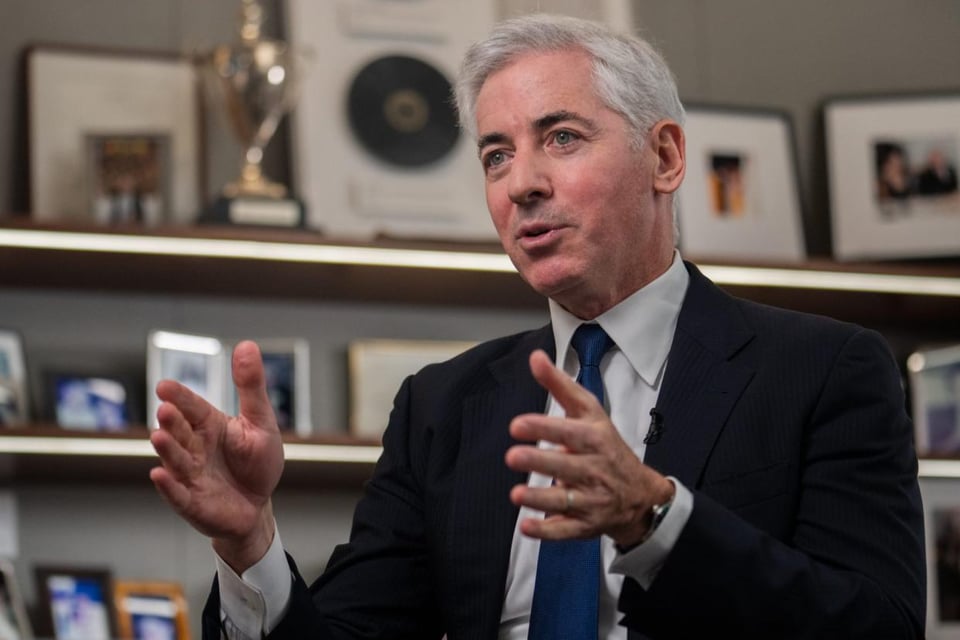
Bill Ackman. He developed his bullying as an activist investor.
Harvard president Claudine Gay may be gone, but billionaire investor Bill Ackman has already aimed his ire at a new target in the heated row over American universities’ response to the Israel-Hamas war.
The activist investor behind hedge fund Pershing Square has waged a campaign against leadership at his alma mater, Harvard, in the wake of the Oct. 7th terrorist attack by Hamas. Ackman has also pushed for the removal of leading figures at two other elite universities which have been accused of tolerating hate speech against Jews—an allegation the universities vehemently deny.
Upon learning that that Gay stepped down only six months into the job, Ackman took to social media to name his next target: Sally Kornbluth, the president of the Massachusetts Institute of Technology (MIT), Harvard’s crosstown rival.
“Et tu, Sally?” he wrote just a half hour after Harvard University newspaper The Crimson broke the news of Gay resigning on Jan. 2.
Gay, Kornbluth, and the University of Pennsylvania’s Liz Magill all made national headlines following their testimony to Congress on Dec. 5, during which they fumbled answers on the policing of anti-Semitic hate speech on campus.
The trio were criticized for being overly bureaucratic, after Gay said calls for the genocide of Jews would only violate university guidelines depending on their context. Critics argued this was a clear double standard that would not have been tolerated in the case of other ethnic or religious minorities.

Liz Magill, head of the University of Pennsylvania, was the first to fall once their testimony went viral on social media, thanks in part to a string of wealthy graduates from its Wharton School of business who threatened to pull their funding pledges.
Harvard’s Gay initially survived Ackman’s campaign, however. Kowtowing to external pressure and condemning their first Black president to the shortest tenure in the institution’s history could have reflected just as badly on the judgment of trustees like Penny Pritzker as well.
But revelations Gay had seemingly committed widespread academic fraud under Harvard’s own stringent standards in what few papers she had published subsequently undermined her authority and made her position untenable.
Ackman has called Gay a diversity hire and blamed DEI for the controversial testimony to Congress.
“The root cause of anti-Semitism at Harvard was an ideology that had been promulgated on campus, an oppressor/oppressed framework, that provided the intellectual bulwark behind the protests, helping to generate anti-Israel and anti-Jewish hate speech and harassment,” he wrote on X.
MIT’s Kornbluth, herself Jewish, is the only one of the three women to have so far successfully resisted calls to resign—a fact Ackman now aims to correct.
‘Under DEI, capitalism is racist’
In December the MIT Corporation published a letter of unequivocal support following Kornbluth’s Dec. 5 testimony. “[Sally] has done excellent work in leading our community, including in addressing anti-Semitism, Islamophobia, and other forms of hate, all of which we reject utterly at MIT,” wrote Mark P. Gorenberg, chair of the MIT Corporation.
In a statement to Fortune, the university did not respond directly to Ackman's comments, but said the its leadership remained focused on ensuring the work of MIT continues.
“This is what happens when liberal universities roll over for right-wing, bad faith bullies,” wrote Mehdi Hasan, a former show host on MSNBC, in response to Ackman’s wish to now see Kornbluth go. “They don’t get appeased. They just come back for more.”

Ackman, who is Jewish and married to an Israeli, explained that the pro-Palestinian protests on university campuses initially sparking his activism turned out to be a symptom of a broader problem America needed to solve—DEI.
In a post on X on Jan. 3 Ackman wrote he believes campus protests against a war—that has so far claimed over 22,000 Palestinian and Israeli lives—is rooted in an ideology that co-opted diversity, equity, and inclusion in pursuit of a political agenda Ackman argues is anti-meritocratic.
“Under DEI, one’s degree of oppression is determined based upon where one resides on a so-called intersectional pyramid of oppression where whites, Jews, and Asians are deemed oppressors, and a subset of people of color, LGBTQ people, and/or women are deemed to be oppressed,” the billionaire speculator wrote. “According to DEI, capitalism is racist.”
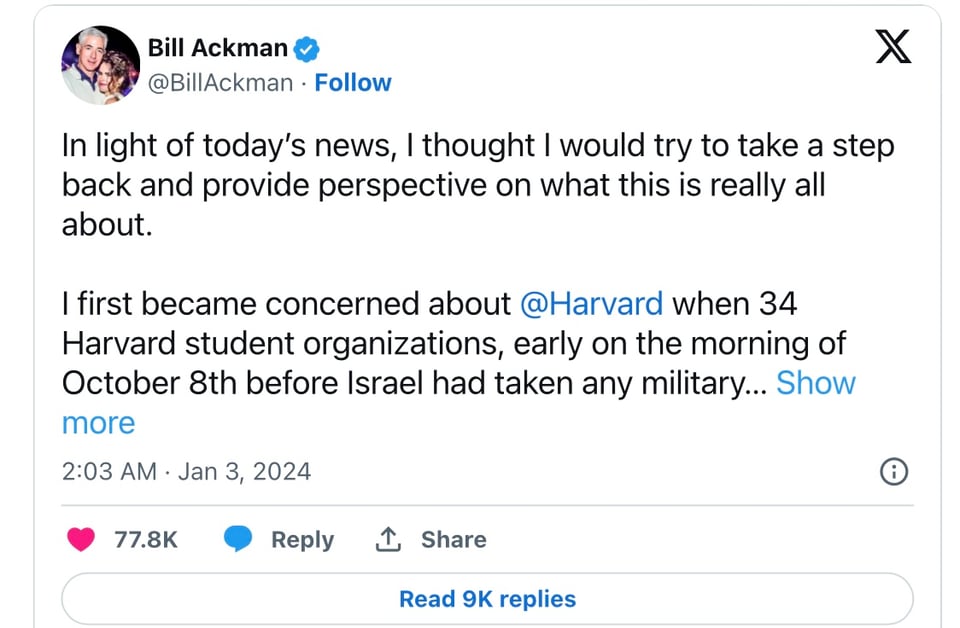
Once this policy is viewed from its ideological heritage, he continued, the only conclusion he can reach is that DEI is “inherently inconsistent with basic American values” and will likely lead to more racism rather than less.
“The DEI movement is an important contributor to our growing divisiveness,” he added.
Not all agree with Ackman. The former director of Harvard’s chapter of the Hillel campus organization for Jewish students warned in the Crimson last week Israeli activists were employing a “McCarthyist tactic of manufacturing an anti-Semitism scare” in order to silence criticism of the country and deflect attention from Gaza’s mounting death toll.
This story was originally featured on Fortune.com
—-
Harvard agitators turn their ire toward Penny Pritzker.
The Dem mega-donor pushes back at hedge-funder Bill Ackman’s call for her to resign.

The leadership turmoil engulfing Harvard University is putting a major Democratic Party figure on the defensive.
Penny Pritzker, a former Obama Cabinet official, current Biden appointee and longtime Democratic megadonor, on Wednesday rejected calls to step down from her role at the top of Harvard’s most powerful governing board.
It comes a day after the resignation of university president Claudine Gay. She stepped down amid growing controversies over her handling of campus antisemitism in the wake of the Oct. 7 Hamas attack on Israel and allegations of academic plagiarism — and as some civil rights activists accused the concerted far-right campaign to oust Harvard’s first Black leader as being motivated by racism.
Pritzker, who led the presidential search that selected Gay last year, is now facing her own scrutiny about her future at the helm of the Harvard Corporation and as Republicans cheer on the chaos shrouding the university.
“Senior fellow Penny Pritzker is not resigning,” a university spokesperson said in a statement to POLITICO on Wednesday.
The announcement comes after Bill Ackman, a hedge fund manager and outspoken critic of Harvard’s handling of claims of antisemitism, called on Pritzker, the former U.S. Commerce secretary, to resign over the handling of Gay’s hiring and ultimate exit from the Ivy League school.
“The Board Chair, Penny Pritzker, should resign along with the other members of the board who led the campaign to keep Claudine Gay, orchestrated the strategy to threaten the media, bypassed the process for evaluating plagiarism, and otherwise greatly contributed to the damage that has been done,” Ackman wrote in a lengthy screed on X, formerly known as Twitter.
Call it the battle of the billionaires. Ackman and Pritzker both sit on the Forbes billionaire list and are noted political donors to Democratic candidates. They are also both Jewish Americans and Harvard alums.
Others on the right also called for Pritzker’s ouster this week, including former Trump administration official Ric Grenell and Christopher Rufo, the conservative activist who helped orchestrate the successful campaign to take down Gay’s leadership of Harvard.
Pritzker was recently tapped by President Joe Biden to serve as special representative for Ukraine’s economic recovery. She’s also the sister of Illinois Gov. JB Pritzker, who announced soon after the Oct. 7 attack by Hamas that Illinois “unequivocally” stands with Israel.
The Pritzkers have long supported Jewish causes. JB Pritzker was the force behind building the Illinois Holocaust and Education Center, donating millions to the center. Penny Pritzker has spoken at events supporting the U.S. Holocaust Museum. She had worked on President Barack Obama’s campaign before being named to head Commerce.
Those close to Pritzker defended her handling of what is undoubtedly a thorny campus crisis. Bruce Andrews, former deputy secretary of Commerce under Pritzker, said he had spoken with Pritzker about her views on Gay. He added that she told him Gay was “a really high quality candidate” for president and a “good leader.”
Regarding issues around Israel and Palestine, Andrews recalled Pritzker’s trip to Babyn Yar in Ukraine, where Jews were massacred in 1941, while at the Commerce Department and her family’s personal history with antisemitism. He has spoken to her at least twice since the issue has taken hold at Harvard.
“She was trying to figure out how to do the right thing and how to make sure that [Harvard] balanced what are a whole bunch of really complicated dynamics,” Andrews said. “You’ve got students with multiple sets of views. You got faculty … you’ve got alumni with multiple sets of views. You have donors with multiple sets of views. You now have the dynamic of Congress weighing in and sort of trying to be part of university oversight.”
“This is a Rubik’s cube of multiple stakeholders,” he added.
At Harvard, Pritzker is the first woman to lead the Harvard Corporation, which led the presidential search that ultimately selected Gay. Pritzker has been on the board since 2018 and became senior fellow in 2022. She had previously served on another governing board at Harvard, the Board of Overseers.
Amid the crisis, the school has benefited at least somewhat from her connections. Pritzker had brought in PR giant Edelman to help Harvard. CEO Richard Edelman was in Massachusetts to assist in the school’s strategy.
Pritzker has also found herself in the crosshairs of congressional lawmakers. In December, Rep. Virginia Foxx (R-N.C.), the chair of the House Education and the Workforce Committee, sent Pritzker a letter asking for documents related to plagiarism allegations against Gay. The letter cites that Harvard’s federal funding “is conditioned upon the school’s adherence to the standards of a recognized accreditor,” which in Harvard’s case requires efforts against plagiarism.
Pritzker has sat on Harvard’s Corporation since 2018 and in 2022 became senior fellow, a role similar to board chair at other universities. She previously served on another governing board at Harvard, the Board of Overseers.
“Higher education is under attack, and I like a challenge,” Prizker said of her Harvard role in a January 2023 Bloomberg interview with David Rubenstein, a fellow billionaire, Democratic donor and a colleague on the Harvard board at the time.
“She’s done an excellent job under very challenging circumstances,” said Alan Solow, a longtime friend who served as co-chair of the Obama reelection campaign with Pritzker. “And I’m not in a position to second-guess any of the decisions that either she or the board has made because nobody on the outside has the full view of the facts that she or the board does.”
“When you’re leading an organization, you do the best you can to get the decisions right,” he added. “There’s no guarantee of 100 percent perfection, and nobody should be held to that. She’s in a very difficult situation, and if I had to choose somebody to try to manage through and provide leadership in a difficult situation, Penny would be at the top of my list.” (Politico).
Harvard Is the Model for Attacking Corporate DEI Efforts.
Bill Ackman and other opponents of diversity, equity and inclusion programs won’t stop with academia.
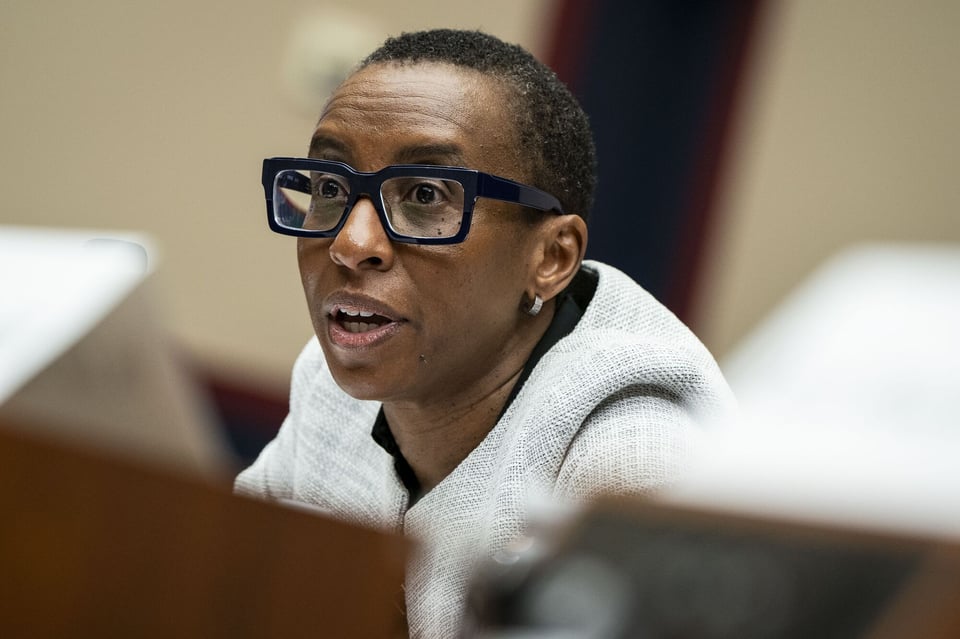
Former Harvard President Claudine Gay. Casualty of the DEI war.
The hottest and most closely watched activist battle isn’t happening inside corporate America. It’s taking place at Harvard University, where Bill Ackman has applied the same playbook he has used in campaigns against the likes of Herbalife Ltd. to one of the most elite and storied institutions in higher education.
The Ackman formula goes something like this: Publicly make your case against management; invite and welcome controversy to generate more buzz; demand a leadership overhaul that includes both the chief executive officer and the board. The fact that this strategy worked so effectively against Claudine Gay, who stepped down as Harvard’s president on Tuesday, is a telling sign that academia has more parallels to the business world than many would care to admit. And if that’s the case, corporate boards nationwide should be on notice that both they and their CEOs face the same risks.
I’ll just state it plainly and prepare myself for the onslaught of hate mail: At its core, the attack on Gay is centered on gender and race. Accusations of plagiarism, criticism of her response to the Oct. 7 attack by Hamas on Israel and Israel’s invasion of Gaza, and her subsequent disastrous congressional testimony all played a role in her ouster, of course. But when it comes down to it, what Ackman and his allies are really agitating for is a reversal of the way diversity, equity and inclusion has become a priority at so many American institutions.
As evidence, consider the letter that Ackman sent Harvard’s governing board on Dec. 10. In it, he contends that the university’s Office of Equity, Diversity, Inclusion, and Belonging is a “major contributing source of discriminatory practices” and “is beyond repair and should be shut down.” He also calls for the board to “launch a detailed investigation into discriminatory hiring practices at the University” that led to the hiring of Gay, who is the first Black person and second woman to lead the institution. Effectively, Ackman seems to be arguing that DEI shouldn’t exist at places like Harvard unless people like him get to define what it means.
Since Gay’s resignation, Ackman has been saying the quiet part out loud. His timeline on X, the platform formerly known as Twitter, is replete with reposts of his cronies claiming that “DEI has corrupted the academy,” that “this is the beginning of the end for DEI in America's institutions,” and “DEI is just another word for racism. Shame on anyone who uses it.” (That last one is from Elon Musk.)
Sub in “business” for the academy and you see where this is going. Ackman might have applied the activist playbook to academia, but he and his supporters now have a blueprint to work toward dismantling DEI efforts inside corporate America. This comes when progress in these areas is already under threat. Chief diversity officers have been targeted in the latest round of corporate layoffs. After finally making progress, the pace of diversifying corporate boards, which have historically been overwhelming white and male, is slowing. Big technology companies are cutting their DEI programs. Looming over it all is the recent Supreme Court decision reversing affirmative action at colleges and universities, which companies are now closely watching out of fear that it could open them up to lawsuits over their own hiring practices. Even companies that remain committed to DEI don’t want to talk about it. As Bloomberg News has reported, companies have spent less time discussing race or LGBTQ issues on earnings calls and are using language like “belonging” rather than the loaded three-letter acronym.
Academia should have looked to the business world to better prepare for the scrutiny that was bound to follow the influx of women into its top jobs; this summer, for the first time, women ran six of the eight Ivy League universities. In the corporate world, female CEOs are more likely to be the target of activist investors — about a 50% higher likelihood, research has shown. Women leaders face greater scrutiny and their competence is questioned more than their male counterparts. Case in point: All three of the university presidents who testified before Congress last month were women.
One of the big critiques of activist investors is that they think in the short term; their goal is to simply make a big return and get out. Corporate boards need to pause for a second and remember why they started taking DEI seriously in the first place. Mark Cuban gave a thoughtful reminder on X last night in response to Musk and his cohort. DEI is about social justice, but it’s also about attracting and retaining top talent, setting them up to succeed and having a workforce and leadership team that reflects the population their companies serve. These are far from short-term goals. In the long run, they’re investments that will pay off. (Beth Kowitt, Bloomberg).
____________________________
Covid is on the rise.
Eve and I wear our masks in crowded places.
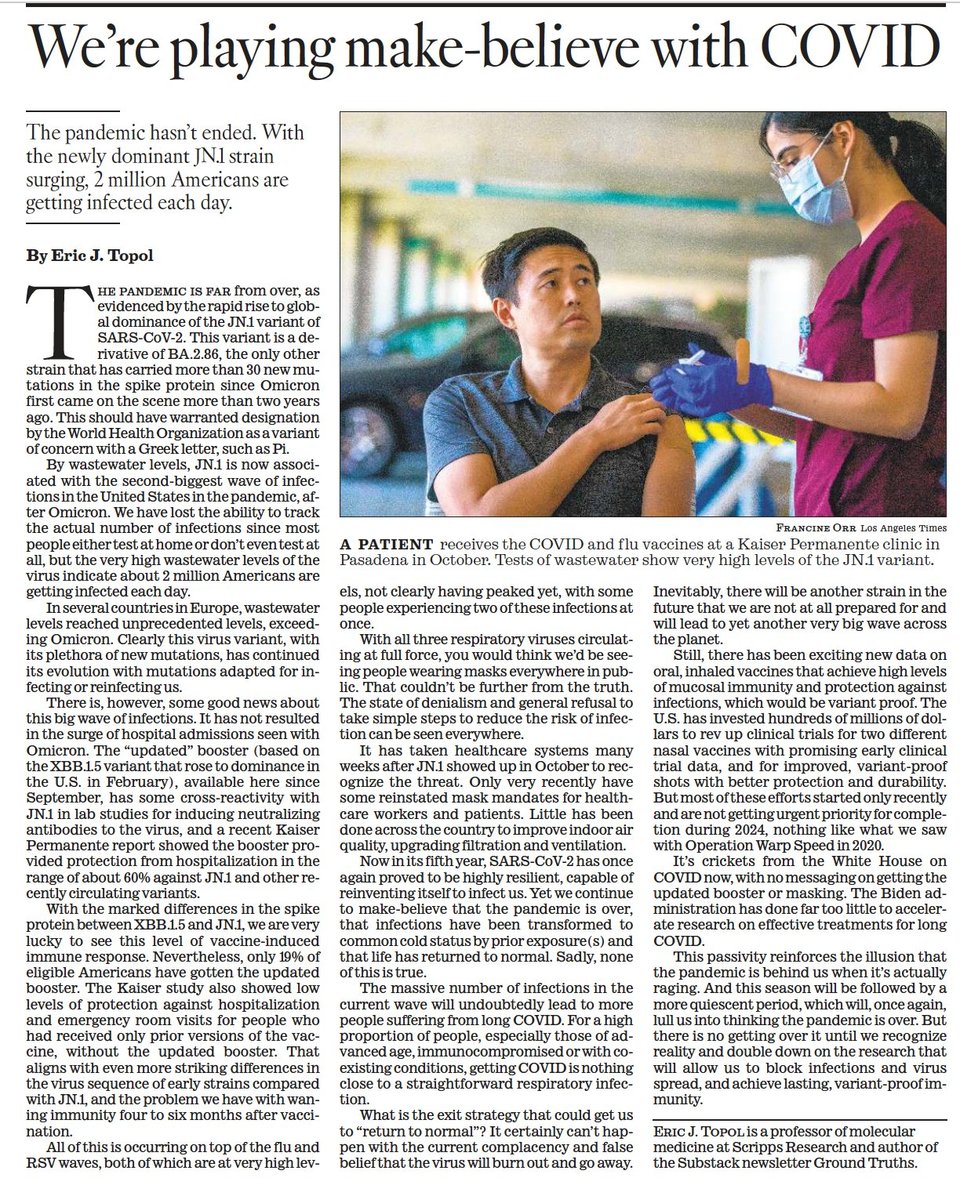
(Los Angeles TIMES).
____________________________
Evan Wolfson, the father of Freedom to Marry, wrote an op-ed on the lessons to be learned from the fight for Marriage Equality to stop the war in the Middle East.
ICYMI: My op-ed on what lessons the success of the @freedomtomarry campaign might hold for Middle East peace. To find the pathway forward we need to look beyond the immediate and heed this moment's call to hope, strategy, and action.https://t.co/riEEoG0aUY
— Evan Wolfson (@evanwolfson) January 4, 2024
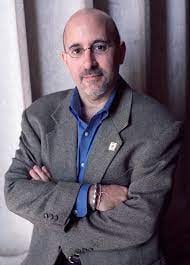
On the college campus where I sometimes teach these days, my students have told me they have never seen their friends so divided. They describe deeply dug-in opposing camps, variously and often vociferously focused on Hamas’s barbaric Oct. 7 attack on Israel, Israel’s military response and the tragic civilian impact in Gaza, one-sided claims as to which side bears responsibility, and feelings of vulnerability and victimhood.
Since the reason I am on campus is to teach strategy and how to move forward and win — drawing on the campaign I led to win marriage for same-sex couples — I thought about what lessons the freedom-to-marry transformation might offer for the admittedly very different, more complex challenge of Middle East peace.
What are some of those lessons?
Don’t be afraid to set a bold goal
In 1983, when I wrote my law school thesis advocating that we fight for the freedom to marry, nowhere in the world could same-sex couples marry. Today, we can on every continent, in 36 countries, including the United States. In books like This is an Uprising, scholars now lift up the Freedom to Marry campaign as an example of transformational, rather than transactional, change. In the latter, advocates choose a goal they believe to be immediately attainable. Transformational change, by contrast, comes about when people aim for the change they really want — undaunted by cynicism, complacency, hopelessness or self-congratulatory “pragmatism.”
I believe the necessary foundation for a future of greater peace, prosperity and happiness for Israelis, Palestinians and their neighbors is the two-state solution, so that is the goal we should proclaim and pursue.
Don’t dwell on the problem. Talk about the pathway
What makes people rally to a bold, seemingly impossible goal is not just the compelling vision but the clarity of strategy: the pathway that will get you there. At Freedom to Marry, we called our strategy the “Roadmap to Victory” and propounded it again and again.
The initial deal yielding a temporary ceasefire and the return of some of the Hamas-held hostages in Gaza demonstrated how progress can be made, even in a bleak moment. Both Israelis and Palestinians need new leaders who articulate the goal and commit to steps that can be taken immediately, as well as some that will proceed in stages on the pathway.
Polls show Israelis agree that Prime Minister Benjamin Netanyahu and his right-wing coalition have to go, and soon. And it is long past time for a new generation of Palestinians, truly committed to peace, to step into power in an overhauled, less corrupt, more capable legitimate government.
The pathway also will require increased investment, pressure and cover from the United States, Arab nations and other key players.
Trust that things, and people, can change
In 1983, only 11% of Americans supported marriage for same-sex couples. Over the next 32 years until we won, I cited lessons from what I called “the scary work of winning.” One such lesson was that while we can’t win every battle and undoubtedly will encounter bitter setbacks, we could, on the right pathway, keep working so as to “lose forward.” And now we are at more than 70% support. Even painful losses can propel gains.
The Middle East conflict illustrates that as well. Out of the 1973 Yom Kippur War came the momentum and leadership that achieved peace between Israel and Egypt and, subsequently, other Arab states. Out of the first intifada came impetus for the Oslo peace process that led to the creation of the Palestinian Authority and what could have been — if not for leadership failures on both sides — a Palestinian state in the West Bank and Gaza already.
Now, too, in the shock and horror of this bitter moment, we must trust that, from bad, we can make good.
Transformation requires building blocks
To build and sustain support, we had to make sure our marriage goal and strategy were accompanied by building blocks of success. Our national strategy called for state-by-state campaigns, incremental achievements and persuasion achieved community by community, conversation by conversation.
Resolution of the Israel-Palestinian conflict must similarly leverage the promise of the two-state solution and a better future to sustain willingness to get there in stages.
Coexistence and security will require real sacrifices. Israel will have to withdraw from many, perhaps most, West Bank settlements; Palestinians will have to accept a period of international engagement that includes peacekeeping forces, perhaps from Arab states or trusted neutrals. Both sides will have to beat back threats from their extremists; neither side will get everything it wants. But both can get a pathway to autonomy, prosperity and an end to bloodshed.
Not everyone who is not yet with you is your foe
At Freedom to Marry, we distinguished between true hard-core opponents and those who, while resistant, fearful or even ignorant, we could persuade. I called them the “reachable but not yet reached.” We worked to give people a pathway to resolve their conflicted feelings and impulses in favor of empathy, growth and acceptance. We didn’t smear or slam the door on those not yet with us. We helped them, as President Barack Obama put it, “evolve.”
Unlike the marriage campaign, the Israeli-Palestinian conflict involves a clash of rights and wrongs on both sides. Yet, too much discourse gets taken or pushed to extremes, swiftly becoming polemical and destructive. One could rehash the long, tangled history of the Middle East — and each side’s deeply held perspectives, myths, narratives and grievances — forever. As Yitzhak Rabin said, “You don’t make peace with friends. You make it with very unsavory enemies.” We don’t have to agree on everything, nor should we allow some disagreement to preclude cooperation.
You don’t need ‘every.’ You need ‘enough’
As with the freedom to marry, the two-state solution does not require bringing everyone along. Extremists, maximalists and nihilists will seek to undermine progress, stoking and engaging in violence. Achieving change doesn't demand universal agreement, just a critical mass.
Change takes time. Progress comes from hope
This is an Uprising offers up the metaphor of a massive dictator’s statue towering above imposing pillars. Advocates of change shake and shake those pillars but nothing seems to happen — until one day, one pillar comes down, then another, and eventually, the whole edifice of oppression collapses.
I often say we can sum up how we won the freedom to marry in three words: Hope, clarity and tenacity. What makes change happen is sticking with the work through challenges and setbacks. What sustains the requisite tenacity is clarity of goal and strategy, leadership, as well as being able to see those building blocks of success that validate and make up the pathway to a better future.
But it all begins with hope: You must believe — and convey to a critical mass — the belief that we can get there.
“If you will it, it is no dream,” wrote Theodore Herzl, founder of the Zionist movement. Or, as the Quran instructs, “If you make it possible, it is possible.”
Evan Wolfson founded and led Freedom to Marry, the campaign to win marriage for same-sex couples. He now advises and assists other causes and countries seeking to adapt the elements of success to other important goals. (The Messenger)
____________________________
Now a word from our sponsor.
How I Got to the Bottom of a Vexing Toilet Paper Mystery.
A “senior scientist” of butt-wiping explains what he’s been up to.

By DAN KOIS.
Not to be too gross about it, but earlier this week I was sitting down, in my bathroom, on the toilet, if you know what I mean, and when I grabbed a new roll of toilet paper, I was dumbfounded. The toilet paper squares—blocky, functional, familiar—were no longer squares. Each perforated edge was not a straight line but a set of gentle curves, like a sound wave. It gave the toilet paper an elegant, scalloped look, as if an interior designer had been hired to class up my butt-wiping.
What on earth was going on? The roll came from a fresh 24-pack of Charmin Ultra Soft, the same brand I always buy, on the grounds that if there’s one area of your body where it’s worth it to spend a little extra, it’s your undercarriage. When I finished up, I went into the storage room to see if the packaging mentioned this new innovation in TP design. The big blue label—aficionados know that, like Beatles greatest-hits records, Charmin comes in blue and red, and you can tell a lot by a person by whether they prefer blue (Ultra Soft) or red (Ultra Strong)—did not, in fact, reveal any difference at all. Indeed, the piece of toilet tissue that the bear on the package was gently pressing to his face, luxuriating in its ultra-softness, was a true square with straight edges, not at all representative of the undulating delights within.
Had some whimsical craftsperson at the Charmin factory hijacked the perforation machine? Was I the subject of a slow-moving psychological experiment, meant to see if humans could become gentler, kinder, less animalistic if our toilet paper is made 7 percent more sophisticated? Googling suggested that others, too, had encountered this TP redesign. Last fall, Katie Arnold-Ratliff at Scary Mommy found a smattering of consumers weighing in on social media platforms and review sites, both pro (“I am in love with the scalloped edges” —Momof2PlustheDog) and con (“little pieces get stuck in my cooch” —laurenm669). While Charmin did reply to some of the posts—“We’re beary sorry to hear about your experience, laurenm669”—the company had not really explained the design change, and did not respond to Arnold-Ratliff’s inquiries. She wondered if, perhaps, this was simply the rare example of a brand injecting a little beauty into their product for fun.
When I emailed Charmin’s media relations department, though, they replied immediately—because I just happened to reach out during the week that the company was finally officiallyrolling out Smooth Tear, its new, improved, scalloped-edge toilet paper, and they were eager for the press. So that is how I found myself on a Zoom with Gregg Weaver, a senior scientist at Procter & Gamble in Cincinnati, to talk about toilet paper R&D. He informed me that the scalloped edges were not merely aesthetic, though he did allow that some people thought they looked good. Wavy edges, Weaver said, are designed to solve the No. 1 problem consumers have with toilet paper: the incomplete tear.
You know—instead of two full squares, you get 1 ⅔, with a long strip left dangling from the roll. “Most people can’t leave that there,” Weaver said. “They feel frustrated. And they tell us about it.” The incomplete tear, Weaver said, is the top complaint Charmin gets on their call-center lines. While I have occasionally been annoyed by an incomplete tear, I admit I have never thought to complain to the toilet paper company. I guess I just thought it was the price you pay for being a human being. I’m too cheap to buy a fancy Japanese toilet seat; therefore, poorly torn toilet paper is my cross to bear. Luckily, other Americans refused to take this problem sitting down, as it were. So the company’s R&D teams were sent out to solve this problem, and five years and 30 patents later, Charmin believes its new wavy-edged toilet paper does away with the incomplete tear.
“Wait,” I said. “Five years?”
The process started with identifying the causes of the problem. Toilet paper fibers mostly run vertically through the roll, Weaver said, which means that when you tear across, you’re tearing against the grain of the paper. And the motions people use to tear vary widely, depending on where the paper lives in their bathroom, whether they’re left-handed or right-handed, whether they prefer over-the-roll or under-the-roll. But most people tear in more of a downward diagonal than a straight line, which leads to that last straggling strand being left on the roll.
We came to the table with a lot of different options,” Weaver said. In the R&D labs, Weaver and other scientists hand-punched perforations into blank rolls of paper, looking for the right shape. They tried a diagonal line, matching the angle of force of the average tear, but discovered, “well, it works great on one side, but not so great on the other.” The group found that the wavy line was best able to withstand the mix of downward and sideways forces in most consumers’ tearing actions. “Once we tried that, the feedback we got was, ‘That tears like a hot knife through butter.’ ”
What took most of those five years, Weaver said, was retooling the company’s six toilet paper factories to accommodate the new era of perforation. “Toilet paper as we knew it before Smooth Tear,” he said, a little grandiosely, “was created back in the Industrial Revolution. Go back 100 years or so, it’s created to run efficiently on a line.” Straight perforations—on a nice, simple, 90-degree angle to the toilet paper running through the machines at 60 miles per hour—are ideal for manufacturing. So once Weaver’s team was convinced that wavy edges were better, they had to oversee changing and replacing the company’s perforation machines in order to deliver that wavy line at speed.
No wonder they’re rolling out these, uh, rolls, with as much media fanfare as possible. They spent actual money on this innovation, which for now, at least, is only available on Charmin Ultra Soft. (“Our Ultra Soft consumers, they’re very experiential. The look, the feel, that bathroom experience, is all important to them,” I was told. Take that, red people, who in my opinion are little better than animals.) Charmin does like to encourage focus on its research and development; a delightful 2019 feature in Popular Science took readers inside the Cincinnati lab, with its robot tear-testers, its “balloon butts,” and its proprietary recipe for synthetic poop.
How does a person become a toilet paper scientist? Weaver’s dad also worked for P&G, he said, and told him that a person could basically get a college education from working at the company. “The majority of my paper science has been learned inside the company, more so than at a college,” he said. Weaver fils has been at Procter for 25 years. As befitting a guy who spends his days thinking about toilet paper, Weaver isn’t all that squeamish talking about the down-and-dirty of the bathroom. “It’s something everybody does,” he says, “and why not enjoy that experience?”
And have I enjoyed my experience with Smooth Tear Ultra Soft Charmin? Though I respect science, I can’t say I’ve seen much of a difference in my tear-completeness rates. I do enjoy the refinement of the curvy edge, which still seems fancier than my gross body deserves. Mostly I’m happy that this is a consumer products mystery of which I was finally able to get to the bottom. (Slate)
____________________________